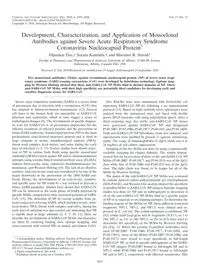
2010 Development, Characterization, and Application of Monoclonal Antibodies against Severe Acute Respiratory Syndrome C PDF
Preview 2010 Development, Characterization, and Application of Monoclonal Antibodies against Severe Acute Respiratory Syndrome C
CLINICAL AND VACCINE IMMUNOLOGY, Dec. 2010, p. 2033–2036 Vol. 17, No. 12 1556-6811/10/$12.00 doi:10.1128/CVI.00293-10 Copyright © 2010, American Society for Microbiology. All Rights Reserved. Development, Characterization, and Application of Monoclonal Antibodies against Severe Acute Respiratory Syndrome Coronavirus Nucleocapsid Protein� Dipankar Das,† Sriram Kammila,† and Mavanur R. Suresh* Faculty of Pharmacy and Pharmaceutical Sciences, University of Alberta, 11304-89 Avenue, Edmonton, Alberta, Canada T6G 2N8 Received 21 July 2010/Returned for modification 19 August 2010/Accepted 24 September 2010 Five monoclonal antibodies (MAbs) against recombinant nucleocapsid protein (NP) of severe acute respi- ratory syndrome (SARS)-causing coronavirus (CoV) were developed by hybridoma technology. Epitope map- ping by Western blotting showed that these anti-SARS-CoV NP MAbs bind to distinct domains of NP. These anti-SARS-CoV NP MAbs, with their high specificity, are potentially ideal candidates for developing early and sensitive diagnostic assays for SARS-CoV. Severe acute respiratory syndrome (SARS) is a severe form of pneumonia due to infection with a coronavirus (CoV) that has adapted to human-to-human transmission (12). Several cell types in the human body are susceptible to SARS-CoV infection and replication, which in turn trigger a series of pathological changes (8). The development of specific diagnos- tic tests for SARS-CoV is of paramount importance for the effective treatment of infected patients and the prevention of future SARS outbreaks. Nucleocapsid protein (NP) is the most predominant virus-derived structural protein and is shed in large amounts in serum, nasopharyngeal aspirate (NPA), throat wash samples, fecal matter, and urine during the early days of infection (1–5, 15). Earlier studies have shown detec- tion of NP in various body fluids using specific monoclonal antibodies (MAbs) raised against NP and its immunodominant epitopes using enzyme-linked immunosorbent assay (ELISA), indirect fluorescence assay, enhanced chemiluminescence im- munoassay, and Western blotting (14). The lack of an effective, sensitive, and easy-to-use assay was considered to be one of the major drawbacks in the prevention of the 2003 SARS out- break. Hence, the development of an easy-to-use, sensitive, and specific assay for NP could be a way forward to prevent a future SARS pandemic. Studies have shown that SARS-CoV NP can be detected in the acute phase of SARS infection by specific MAbs, compared to other structural proteins of SARS- CoV (15). The detection of NP in various samples from pa- tients suspected of having SARS, which included serum, urine, fecal matter, NPA, throat wash samples, and saliva, during the early days of infection was also carried out, indicating that NP is rapidly shed in large amounts (2, 4, 7, 10, 11). Here we describe the development of SARS-CoV MAbs and character- ize them by analyzing binding sites, epitope mapping, and cross-reactivity with related NPs of animal and human CoVs. Five BALB/c mice were immunized with Escherichia coli expressing SARS-CoV NP (6) following a set immunization protocol (13). Based on high antibody titers, splenocytes were isolated from the immunized mice and fused with freshly grown SP2/0 myeloma cells using polyethylene glycol. After a third recloning step, five stable anti-SARS-CoV NP clones were generated against SARS-CoV NP and designated P140.20B7, P140.19B6, P140.19C7, P140.1D3, and P140.14D6. Each anti-SARS-CoV NP hybridoma clone was cultured, and supernatants were purified by protein G agarose chromatog- raphy. The range of immunoglobulin G (IgG) yields was 6 to 24 mg/liter of cell culture supernatant. Isotyping of the five MAbs was done by using a commercially available isotyping kit (Sigma-Aldrich). The results demon- strated that the heavy chain of three of the anti-SARS-CoV NP MAbs (P140.20B7, P140.19C7, and P140.1D3) was of the IgG1 class while that of P140.19B6 and P140.1D3 was of the IgG2 class. The light chain was found to be kappa for all of the MAbs by Western blotting. The purity of the anti-SARS-CoV NP MAbs was evaluated by sodium dodecyl sulfate-polyacrylamide gel electrophoresis (SDS-PAGE), and Western blot analysis showed the specificity of purified MAbs to SARS-CoV NP antigen. Epitope mapping studies was done for NP and its subfragments to determine if all of the anti-SARS-CoV NP MAbs bind to a specific region of NP or to separate or overlapping epitopes. To determine the binding regions of the MAbs on NP, three different truncated fragments, NP1.1, NP1.2, and NP1.3, were cloned and ex- pressed in E. coli (6). The codon-optimized recombinant NP (422 amino acids [aa]) gene and its fragments (N.P1.1, aa 1 to 140; NP1.2, aa 141 to 280; NP1.3, aa 281 to 422) were used to determine the specificity of the MAbs by Western blotting (6) (Fig. 1). When the protein G-purified antibodies were used (P140.20B7, P140.19B6, P140.19C7, P140.14D6, and P140.19D3), three of the MAbs (P140.20B7, P140.19B6, and P140.19C7) were found to react specifically to full-length SARS-CoV NP, as well as specific subfragments of the SARS- CoV NP antigen. P140.20B7 bound to full-length NP and to NP1.3, while P140.19B6 and P140.19C7 bound to full-length NP and to NP1.2, respectively, with different sensitivities. This * Corresponding author. Mailing address: Faculty of Pharmacy and Pharmaceutical Sciences, University of Alberta, 11304-89 Avenue, Ed- monton, Alberta, Canada T6G 2N8. Phone: (780) 492-9233. Fax: (780) 492-1217. E-mail:
